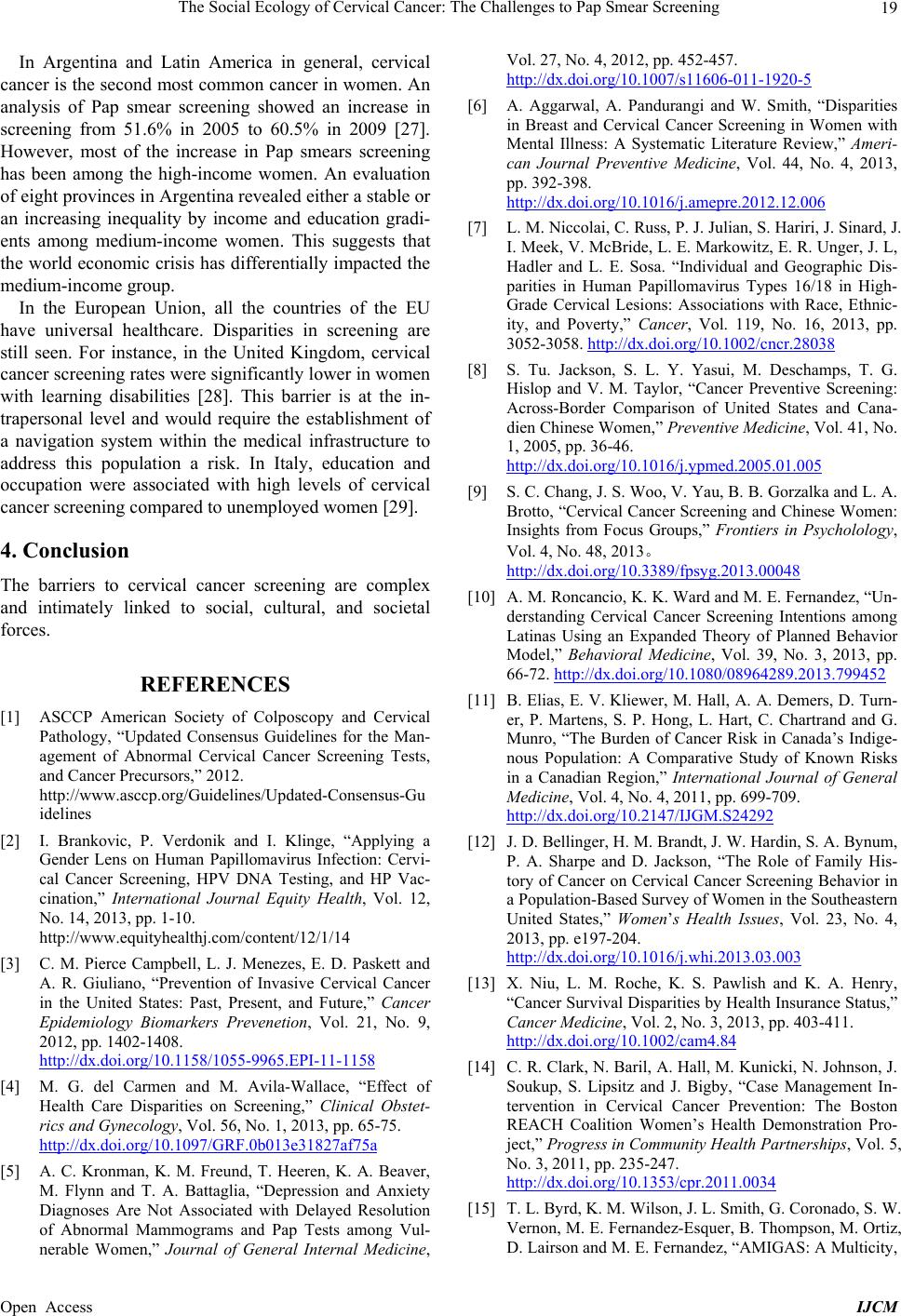
The Social Ecology of Cervical Cancer: The Challenges to Pap Smear Screening 19
In Argentina and Latin America in general, cervical
cancer is the second most common cancer in women. An
analysis of Pap smear screening showed an increase in
screening from 51.6% in 2005 to 60.5% in 2009 [27].
However, most of the increase in Pap smears screening
has been among the high-income women. An evaluation
of eight provinces in Argentina revealed either a stable or
an increasing inequality by income and education gradi-
ents among medium-income women. This suggests that
the world economic crisis has differentially impacted the
medium-income group.
In the European Union, all the countries of the EU
have universal healthcare. Disparities in screening are
still seen. For instance, in the United Kingdom, cervical
cancer screening rates were significantly lower in women
with learning disabilities [28]. This barrier is at the in-
trapersonal level and would require the establishment of
a navigation system within the medical infrastructure to
address this population a risk. In Italy, education and
occupation were associated with high levels of cervical
cancer screening compared to unemployed women [29].
4. Conclusion
The barriers to cervical cancer screening are complex
and intimately linked to social, cultural, and societal
forces.
REFERENCES
[1] ASCCP American Society of Colposcopy and Cervical
Pathology, “Updated Consensus Guidelines for the Man-
agement of Abnormal Cervical Cancer Screening Tests,
and Cancer Precursors,” 2012.
http://www.asccp.org/Guidelines/Updated-Consensus-Gu
idelines
[2] I. Brankovic, P. Verdonik and I. Klinge, “Applying a
Gender Lens on Human Papillomavirus Infection: Cervi-
cal Cancer Screening, HPV DNA Testing, and HP Vac-
cination,” International Journal Equity Health, Vol. 12,
No. 14, 2013, pp. 1-10.
http://www.equityhealthj.com/content/12/1/14
[3] C. M. Pierce Campbell, L. J. Menezes, E. D. Paskett and
A. R. Giuliano, “Prevention of Invasive Cervical Cancer
in the United States: Past, Present, and Future,” Cancer
Epidemiology Biomarkers Prevenetion, Vol. 21, No. 9,
2012, pp. 1402-1408.
http://dx.doi.org/10.1158/1055-9965.EPI-11-1158
[4] M. G. del Carmen and M. Avila-Wallace, “Effect of
Health Care Disparities on Screening,” Clinical Obstet-
rics and Gynecology, Vol. 56, No. 1, 2013, pp. 65-75.
http://dx.doi.org/10.1097/GRF.0b013e31827af75a
[5] A. C. Kronman, K. M. Freund, T. Heeren, K. A. Beaver,
M. Flynn and T. A. Battaglia, “Depression and Anxiety
Diagnoses Are Not Associated with Delayed Resolution
of Abnormal Mammograms and Pap Tests among Vul-
nerable Women,” Journal of General Internal Medicine,
Vol. 27, No. 4, 2012, pp. 452-457.
http://dx.doi.org/10.1007/s11606-011-1920-5
[6] A. Aggarwal, A. Pandurangi and W. Smith, “Disparities
in Breast and Cervical Cancer Screening in Women with
Mental Illness: A Systematic Literature Review,” Ameri-
can Journal Preventive Medicine, Vol. 44, No. 4, 2013,
pp. 392-398.
http://dx.doi.org/10.1016/j.amepre.2012.12.006
[7] L. M. Niccolai, C. Russ, P. J. Julia n, S. Hariri, J. Sinard, J.
I. Meek, V. McBride, L. E. Markowitz, E. R. Unger, J. L,
Hadler and L. E. Sosa. “Individual and Geographic Dis-
parities in Human Papillomavirus Types 16/18 in High-
Grade Cervical Lesions: Associations with Race, Ethnic-
ity, and Poverty,” Cancer, Vol. 119, No. 16, 2013, pp.
3052-3058. http://dx.doi.org/10.1002/cncr.28038
[8] S. Tu. Jackson, S. L. Y. Yasui, M. Deschamps, T. G.
Hislop and V. M. Taylor, “Cancer Preventive Screening:
Across-Border Comparison of United States and Cana-
dien Chinese Women,” Preventive Medicine, Vol. 41, No.
1, 2005, pp. 36-46.
http://dx.doi.org/10.1016/j.ypmed.2005.01.005
[9] S. C. Chang, J. S. Woo, V. Yau, B. B. Gorzalka and L. A.
Brotto, “Cervical Cancer Screening and Chinese Women:
Insights from Focus Groups,” Frontiers in Psycholology,
Vol. 4, No. 48, 2013。
http://dx.doi.org/10.3389/fpsyg.2013.00048
[10] A. M. Roncancio, K. K. Ward and M. E. Fernandez, “Un-
derstanding Cervical Cancer Screening Intentions among
Latinas Using an Expanded Theory of Planned Behavior
Model,” Behavioral Medicine, Vol. 39, No. 3, 2013, pp.
66-72. http://dx.doi.org/10.1080/08964289.2013.799452
[11] B. Elias, E. V. Kliewer, M. Hall, A. A. Demers, D. Turn-
er, P. Martens, S. P. Hong, L. Hart, C. Chartrand and G.
Munro, “The Burden of Cancer Risk in Canada’s Indige-
nous Population: A Comparative Study of Known Risks
in a Canadian Region,” International Journal of General
Medicine, Vol. 4, No. 4, 2011, pp. 699-709.
http://dx.doi.org/10.2147/IJGM.S24292
[12] J. D. Bellinger, H. M. Brandt, J. W. Hardin, S. A. By num,
P. A. Sharpe and D. Jackson, “The Role of Family His-
tory of Cancer on Cervical Cancer Screening Behavior in
a Population-Based Survey of Women in the Southeastern
United States,” Women’s Health Issues, Vol. 23, No. 4,
2013, pp. e197-204.
http://dx.doi.org/10.1016/j.whi.2013.03.003
[13] X. Niu, L. M. Roche, K. S. Pawlish and K. A. Henry,
“Cancer Survival Disparities by Health Insurance Status,”
Cancer Medicine, Vol. 2, No. 3, 2013, pp. 403-411.
http://dx.doi.org/10.1002/cam4.84
[14] C. R. Clark, N. Baril, A. Hall, M. Kunicki, N. Johnson, J.
Soukup, S. Lipsitz and J. Bigby, “Case Management In-
tervention in Cervical Cancer Prevention: The Boston
REACH Coalition Women’s Health Demonstration Pro-
ject,” Progress in Community Health Partnerships, Vol. 5,
No. 3, 2011, pp. 235-247.
http://dx.doi.org/10.1353/cpr.2011.0034
[15] T. L. Byrd, K. M. Wilson, J. L. Smith, G. Coronado, S. W.
Vernon, M. E. Fernandez-Esquer, B. Thompson, M. Ortiz,
D. Lairson and M. E. Fernandez, “AMIGAS: A Multicity,
Open Access IJCM